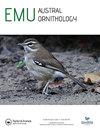Birds on farms: a review of factors influencing bird occurrence in the temperate woodlands of south-eastern Australia
IF 1.1
4区 生物学
Q3 ORNITHOLOGY
引用次数: 2
Abstract
ABSTRACT Australia’s temperate woodlands are among the most heavily modified biomes globally. I summarise some of the work on birds in south-eastern Australia that identifies drivers of bird biodiversity loss and the effectiveness of management interventions. I particularly focus on studies by the Sustainable Farms project at The Australian National University which show that: (1) Bird occurrence is associated with the amount of woody vegetation cover at site, farm and landscape scales. (2) Planting to increase woodland cover has greater relative positive effects on birds than grazing control. However, grazing of plantings has inherently negative impacts. (3) There are different broad structural types of woodland (old growth, regrowth and replantings) and each supports different bird assemblages. (4) The highest bird biodiversity occurs on farms which support all three woodland structural types, as well as other natural assets like paddock trees and fallen timber. (5) Long-term data show that while some woodland species are increasing, twice as many species are declining. Despite the body of information on woodland birds, substantial knowledge gaps remain. These include understanding of: (1) the role of fire in woodland bird dynamics and habitat suitability, and (2) demographic processes like bird breeding success and how it affects long-term site occupancy. Bird biodiversity in Australian agricultural landscapes formerly dominated by temperate woodlands will be best supported by: (1) ceasing land clearing, (2) greater woodland regeneration and woodland planting, (3) limiting livestock grazing, and (4) limiting the impacts of the Noisy Miner (Manorina melanocephala).农场上的鸟类:澳大利亚东南部温带林地鸟类发生的影响因素综述
澳大利亚的温带林地是全球生物群落变化最严重的地区之一。我总结了一些关于澳大利亚东南部鸟类的工作,这些工作确定了鸟类生物多样性丧失的驱动因素和管理干预的有效性。我特别关注澳大利亚国立大学可持续农场项目的研究,该项目表明:(1)鸟类的发生与现场、农场和景观尺度上木本植被覆盖的数量有关。(2)增加林地覆盖对鸟类的相对正向影响大于放牧。然而,放牧有其固有的负面影响。(3)林地有不同的结构类型(原生林、再生林和再生林),每种结构类型支持不同的鸟类组合。(4)鸟类生物多样性最高的是支持所有三种林地结构类型的农场,以及围场树木和砍伐木材等其他自然资产。(5)长期数据表明,在一些林地物种增加的同时,有两倍的物种在减少。尽管有大量关于林地鸟类的信息,但仍存在大量的知识空白。这些包括理解:(1)火灾在林地鸟类动态和栖息地适宜性中的作用;(2)鸟类繁殖成功等人口统计过程及其对长期用地占用的影响。在以前以温带林地为主的澳大利亚农业景观中,鸟类的生物多样性将通过以下方式得到最好的支持:(1)停止土地清理,(2)更多的林地更新和林地种植,(3)限制牲畜放牧,(4)限制吵闹的矿工(Manorina melanocephala)的影响。
本文章由计算机程序翻译,如有差异,请以英文原文为准。
求助全文
约1分钟内获得全文
求助全文
来源期刊

Emu-Austral Ornithology
生物-鸟类学
CiteScore
2.00
自引率
7.70%
发文量
33
审稿时长
>12 weeks
期刊介绍:
Emu – Austral Ornithology is the premier journal for ornithological research and reviews related to the Southern Hemisphere and adjacent tropics. The journal has a long and proud tradition of publishing articles on many aspects of the biology of birds, particularly their conservation and management.
 求助内容:
求助内容: 应助结果提醒方式:
应助结果提醒方式:


